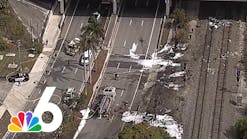There is a saying that those who do not learn from history are destined to repeat it. That was meant to have a negative connotation. But what if we do learn from history does that somehow automatically imply that we will have successful outcomes?
Learning from history is good, don't get me wrong. It's good if we learn a valuable lesson from it. We spoke of lessons in the article on experience. Learning from history will give us the background knowledge for us to formulate opinions of what will work and what will not.
The fire service is built on tradition -- that is a fancier word for our history. We have learned to put out fires from those who have come before us. We have learned the values of firefighters from their examples. We can figure out what will work and what doesn't from this information.
Learning from history can have a pit fall. That is you can't base your whole strategy on what worked before. Years ago structures were built with dimensional lumber that burned at a predictable rate. So much wood, so much fire and we would know how long it would take to collapse. That is not the case in today's lightweight construction. Less wood, more fire from today's hotter burning plastics and collapse times can no longer be accurately predicted.
If we employ yesterdays fire attack method to today's fire it could be deadly. Even though we have learned from history, we did need to wait and get people killed, until our history caught up with our own ability to understand lightweight construction. Basically, until lightweight construction had a history. The same can be said of bowstring and unprotected steel trusses.
Hopefully we got passed that. The goal here is to be able to recognize what is the next generation of killers and be proactive in response to the threat.
The reason armies lose wars is because they learn from what they did in the last war and apply it the war they are fighting. This can be a flaw. The enemy has also studied your tactics and has adjusted his to defeat you. If you don't change and adjust again they will win.
The fire service has been fighting the fight for improved fire prevention codes for years. Mandatory smoke detectors, sprinkler requirements and challenging the performance standard for lightweight construction have all been in response to tragedy. Recently, carbon monoxide detection has come to the forefront in the fire service. Our response has changed to how these alarms are handled. All this is good but we need to be looking ahead.
Our "enemy" and I don't mean to speak of them, as the enemy, is the building trades and property owners. I understand their point, profit. They want to build the biggest, cheapest structure they can and rent it for the most money. Maybe cheapest is a hash word, for the sake of political correctness I will say least expensive. But they need to indulge my political correctness because if the choice was marble tile or automatic sprinklers I don't think there would be much discussion. So I say they are building a cheap building because it lacks substance.
The fire service, and sadly most of our society, determines threat based on trends. Trends come from statistical analysis of history. How do we get that information? People have to die.
Have you ever had the experience where you said to yourself, "that road is dangerous" or "they should install a traffic light at that intersection?" You have recognized the danger but when does the speed limit get reduced or maybe enforced or the light get installed? When the bodies pile up.
I don't mean to pick on the department of transportation guys, they were just an easy example, but the fire service is just as guilty. How many NFPA standards are written in firefighters blood? Just glance at NFPA 1403. If you are a fire service leader and you are unfamiliar with it shame on you. For those not from the fire service NFPA 1403 is a code of conduct for live fire training in acquired structures. It sets out the rules of engagement. Those who have not complied have been held criminally liable for their actions. This is where those who have not learned from history have repeated it and killed people.
So why is this an article in a series on leadership. We have all heard catchy phrases like "think outside the box," or "don't bury your head in the sand." The fire service works in the sandbox and so do building trades and building owners. If you want to take all the sand and pile it up, understand the consequence. Another catchy phrase "don't build on shifting sand."
The fire service needs to engage the building trades and property owners on their level. There is no acceptable loss of life from fire, civilian of firefighter. If you build a cheap building you will be held accountable. Make them understand that their fancy building is not worth your members lives.
Do we need to educate the public and make them aware of the impact this has on their lives. Insurance money can replace things but sentimental value is not considered. If your home burns it is probably cheaper to cart the whole thing off in a dumpster and rebuild from scratch. To them it is a house to you it is a home your home!
Make them build a building that can be saved, one that is worth saving. What is being saved is your stuff, maybe even your life.
Don't wait for the trend to be discovered. Think outside the box for ways to encourage dialog for the building people. Don't bury your head in the sand and say it wont happen to me.
A leader thinks on his or her feet and uses their head for more than just a rack to put their white hat on!
Comments are always welcomed. You can e-mail them to me at [email protected]. Stay safe.
CHRISTOPHER FLATLEY, a Firehouse.com Contributing Editor, is a 20-year veteran of the FDNY and a lieutenant currently assigned to Ladder Company 21 in Manhattan. Chris has twice served as chief of the Blauvelt, NY, Volunteer Fire Company and is currently the assistant chief and training coordinator. He is a nationally certified Fire Instructor 1 and is an instructor at the Rockland County, NY, Fire Training Center and holds a degree in fire protection technology. He is a Master Exercise Practitioner on the Exercise Design Team through the Center for Terrorism and Disaster Preparedness. You can reach Chris by e-mail at: [email protected].

Christopher Flatley | Firehouse.com Contributor
Lt. Christopher Flatley is a 20-year veteran of the FDNY, currently assigned to Ladder Company 21in the "Hells Kitchen" section of Manhattan. Prior to promotion he worked in Ladder Company 2 in "Midtown". He is a Master Exercise Practitioner on the Exercise Design Team through the Center for Terrorism and Disaster Preparedness. He is a member of the Incident Management Team and Family Assistance Units.
Chris has twice served as Chief of the Blauvelt Volunteer Fire Company and is currently the Assistant Chief and training coordinator. He is a Nationally Certified Fire Instructor 1 and is an instructor at the Rockland County Fire Training Center, Pomona N.Y. and holds a degree in Fire Protection Technology.
He has presented seminars and lectured nationally on various fire service topics and has written articles for leading fire service publications including WNYF, the official publication of the New York City Fire Department and Size Up the New York State Association of Fire Chiefs quarterly magazine. You can reach Chris by e-mail at: [email protected]





